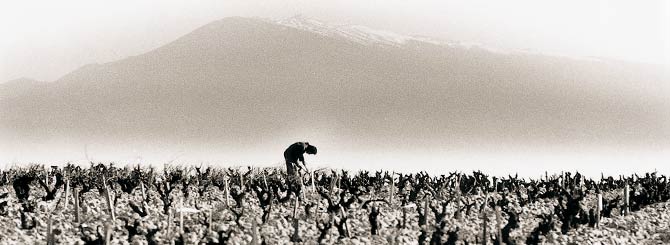
Domaine du Vieux Télégraphe has been run by the Brunier family for six generations since 1891. The estate’s vineyards, 60-years-old on average, are planted on the celebrated Plateau of La Crau, a site renowned for grape-growing in Châteauneuf-du-Pape. This terroir imparts to their wines a highly distinctive minerality, as if they have been filtered through the thick layer of large pebbles left behind when the Alpine glaciers melted, long before the Rhône Valley formed.
History
Henri Brunier penned the first chapter of this family's story in 1891, in the village of Bédarrides, known today for occupying the southeastern portion of the Châteauneuf-du-Pape AOC area. In that year, he gifted his son Hippolyte a few plots of land on La Crau, a place that was considered practically unfit for cultivation in those days due to the soil's high density of pebbles.
Hippolyte Brunier planted his first vine stocks on this commanding plateau. At the time, only 2.5 acres of vines was cultivated with grapes and the remaining land was used to grow fruits and vegetables, which in those days, made more money than grapes used for wine. In 1821, Claude Chappe, inventor of the optical telegraph, built one of his signal towers on the land. Hippolyte’s son, Jules, extended the estate to 42 acres and aptly named the fruits of his labours “Vieux Télégraphe” after Claude Chappe's ageing signal tower.
At the end of the Second World War, Henri, the second thus named and the fourth generation, had the formidable task of reviving the estate and shaping its destiny. Not content with enlarging the Domaine to a single expanse of 136 acres, he gave this classic Châteauneuf-du-Pape wine its full dimension, creating a “Vieux Télégraphe” style and positioning it on all the world’s leading markets.
Since the early 1980s his two sons, Frédéric and Daniel, have been tending to the family estate. They now farm 247 acres in the Châteauneuf-du-Pape AOC area, and 49.5 acres of IGP Vaucluse and AOC Ventoux vines. Furthermore, they acquired Domaine Les Pallières in 1998 in partnership with family friend Kermit Lynch. The single-plot 309-acre estate in Gigondas has 62 acres of vines.
Left: Frédéric and Daniel Brunier (fifth generation), Right: Nicolas and Edouard Brunier (sixth generation)
Domaine Les Pallières was undeniably one of the greatest, longest-running properties of the Southern Rhône. The Domaine had been a continuously running farm with the same family since the 15th century. Les Pallières was once a famous Domaine with wines of impeccable character, yet the property had slowly fallen into disrepair. Two great frosts of the 20th century had killed off many of the olive and fruit trees, and both the winery and vineyards were badly in need of repairs. By 1998, the Roux brothers wanted to make a change, however, with no future successors, they decided to sell.
The Brunier brothers, Daniel and Frédéric, of Vieux Télégraphe in Châteauneuf-du-Pape, were rising stars in the Southern Rhône at that time and have distinguished themselves with world-class wines. A casual discussion over lunch spontaneously turned into a game plan to revive the faded jewel. Though the competition to buy the Domaine was fierce with very reputable names in the mix, the Roux brothers finally decided to sell to the Bruniers and Kermit. After decades of neglect, Pallières’ renaissance had begun.
After more than 125 years in existence, the Domaine and its associated vineyards, guided by the fifth and the sixth generations of vignerons, have retained all of its initial philosophy.
Philosophy
Organic-raisonné and sustainable grape-growing is the core of their philosophy. Whether their team of vignerons are labouring on the hot Plateau of La Crau, in the lieux-dits of Pignan, La Roquète and Piedlong, or on the cold steep slopes in the district of Les Pallières, they are driven all year round by the conviction that the grapes should be able to thrive and be picked in the best possible conditions.
Fine fruit is essential for a fine vintage. To achieve this, tasks are tailored to each parcel of vines: for instance, pruning, the spreading of organic manure and traditional ploughing are winter chores that may seem straightforward at first glance, but in fact demand great care. In springtime and summer, the same applies for the debudding, done by hand, and the removal of surplus unripe grapes and surplus leaves; balance is everything, and practically each vine enjoys its own.
The treatments effected during the vegetative period respect the rules of organic agriculture and are also raisonnés, in order to meet two main goals: zero residues in the wines and minimal external pollution.
To fight vine moths (eudemis and cochylis), they have used the technique known as “sexual confusion” since 1997. This involves saturating the vineyards with female pheromones so that the disoriented male butterflies have trouble mating. This results in fewer grape worms and healthier grapes. Harvesting illustrates their philosophy of respect for tradition: the grapes are picked by hand and sorted twice, so that their winemakers receive the healthiest possible fruit. One last detail, which is indispensable to the concepts of terroir and AOC classification: they do not irrigate their vineyards.




















































